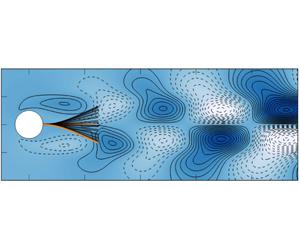当前位置:
X-MOL 学术
›
J. Fluid Mech.
›
论文详情
Our official English website, www.x-mol.net, welcomes your feedback! (Note: you will need to create a separate account there.)
Fluid–structure stability analyses and nonlinear dynamics of flexible splitter plates interacting with a circular cylinder flow
Journal of Fluid Mechanics ( IF 3.7 ) Pub Date : 2020-06-05 , DOI: 10.1017/jfm.2020.284 J.-L. Pfister , O. Marquet
Journal of Fluid Mechanics ( IF 3.7 ) Pub Date : 2020-06-05 , DOI: 10.1017/jfm.2020.284 J.-L. Pfister , O. Marquet

|
The dynamics of a hyperelastic splitter plate interacting with the laminar wake flow of a circular cylinder is investigated numerically at a Reynolds number of 80. By decreasing the plate’s stiffness, four regimes of flow-induced vibrations are identified: two regimes of periodic oscillation about a symmetric position, separated by a regime of periodic oscillation about asymmetric positions, and finally a regime of quasi-periodic oscillation occurring at very low stiffness and characterized by two fundamental (high and low) frequencies. A linear fully coupled fluid–solid analysis is then performed and reveals the destabilization of a steady symmetry-breaking mode, two high-frequency unsteady modes and one low-frequency unsteady mode, when varying the plate’s stiffness. These unstable eigenmodes explain the emergence of the nonlinear self-sustained oscillating states and provide a good prediction of the oscillation frequencies. A comparison with nonlinear calculations is provided to show the limits of the linear approach. Finally, two simplified analyses, based on the quiescent-fluid or quasi-static assumption, are proposed to further identify the linear mechanisms at play in the destabilization of the fully coupled modes. The quasi-static static analysis allows an understanding of the behaviour of the symmetry-breaking and low-frequency modes. The quiescent-fluid stability analysis provides a good prediction of the high-frequency vibrations, unlike the bending modes of the splitter plate in vacuum, as a result of the fluid added-mass correction. The emergence of the high-frequency periodic oscillations can thus be predicted based on a resonance condition between the frequencies of the hydrodynamic vortex-shedding mode and of the quiescent-fluid solid modes.
中文翻译:

柔性分流板与圆柱流相互作用的流固耦合稳定性分析和非线性动力学
在雷诺数为 80 时,对与圆柱体层流尾流相互作用的超弹性分流板的动力学进行了数值研究。通过降低板的刚度,确定了四种流动引起的振动状态:围绕 a 的两种周期性振荡状态对称位置,由关于非对称位置的周期性振荡机制隔开,最后是在非常低的刚度下发生的准周期振荡机制,并以两个基本(高和低)频率为特征。然后进行线性全耦合流固分析,并揭示了当改变板的刚度时,稳态对称破坏模式、两种高频非稳态模式和一种低频非稳态模式的不稳定。这些不稳定的本征模式解释了非线性自持振荡状态的出现,并提供了对振荡频率的良好预测。提供了与非线性计算的比较以显示线性方法的局限性。最后,提出了两种基于静态流体或准静态假设的简化分析,以进一步确定在完全耦合模式的不稳定中起作用的线性机制。准静态静态分析允许了解对称破坏和低频模式的行为。静态流体稳定性分析提供了对高频振动的良好预测,这与真空中分流板的弯曲模式不同,这是流体附加质量校正的结果。
更新日期:2020-06-05
中文翻译:

柔性分流板与圆柱流相互作用的流固耦合稳定性分析和非线性动力学
在雷诺数为 80 时,对与圆柱体层流尾流相互作用的超弹性分流板的动力学进行了数值研究。通过降低板的刚度,确定了四种流动引起的振动状态:围绕 a 的两种周期性振荡状态对称位置,由关于非对称位置的周期性振荡机制隔开,最后是在非常低的刚度下发生的准周期振荡机制,并以两个基本(高和低)频率为特征。然后进行线性全耦合流固分析,并揭示了当改变板的刚度时,稳态对称破坏模式、两种高频非稳态模式和一种低频非稳态模式的不稳定。这些不稳定的本征模式解释了非线性自持振荡状态的出现,并提供了对振荡频率的良好预测。提供了与非线性计算的比较以显示线性方法的局限性。最后,提出了两种基于静态流体或准静态假设的简化分析,以进一步确定在完全耦合模式的不稳定中起作用的线性机制。准静态静态分析允许了解对称破坏和低频模式的行为。静态流体稳定性分析提供了对高频振动的良好预测,这与真空中分流板的弯曲模式不同,这是流体附加质量校正的结果。


























 京公网安备 11010802027423号
京公网安备 11010802027423号